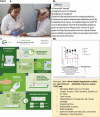Building Programs to Eradicate Toxoplasmosis Part IV: Understanding and Development of Public Health Strategies and Advances "Take a Village"
- PMID: 35991908
- PMCID: PMC9379243
- DOI: 10.1007/s40124-022-00268-x
Building Programs to Eradicate Toxoplasmosis Part IV: Understanding and Development of Public Health Strategies and Advances "Take a Village"
Abstract
Purpose of review: Review international efforts to build a global public health initiative focused on toxoplasmosis with spillover benefits to save lives, sight, cognition and motor function benefiting maternal and child health.
Recent findings: Multiple countries' efforts to eliminate toxoplasmosis demonstrate progress and context for this review and new work.
Summary: Problems with potential solutions proposed include accessibility of accurate, inexpensive diagnostic testing, pre-natal screening and facilitating tools, missed and delayed neonatal diagnosis, restricted access, high costs, delays in obtaining medicines emergently, delayed insurance pre-approvals and high medicare copays taking considerable physician time and effort, harmful shortcuts being taken in methods to prepare medicines in settings where access is restricted, reluctance to perform ventriculoperitoneal shunts promptly when needed without recognition of potential benefit, access to resources for care, especially for marginalized populations, and limited use of recent advances in management of neurologic and retinal disease which can lead to good outcomes.
Supplementary information: The online version contains supplementary material available at 10.1007/s40124-022-00268-x.
Keywords: antiparasitic treatment; congenital toxoplasmosis; diagnostic testing; marginalized populations; point-of-care testing; prenatal screening.
© The Author(s) 2022.
Conflict of interest statement
Conflict of Interest/Competing Interests There are no other disclosures and no other competing interests.
Figures







References
-
- Mcleod R, Mack DG, Boyer K, Mets M, Roizen N, Swisher C, Patel D, Beckmann E, Vitullo D, Johnson D, et al. Phenotypes and functions of lymphocytes in congenital toxoplasmosis. J Lab Clin Med. 1990;116(5):623–635. - PubMed
-
- McGee T, Wolters C, Stein L, Kraus N, Johnson D, Boyer K, Mets M, Roizen N, Beckman J, Meier P, Swisher C, Holfels E, Withers S, McLeod R. Absence of sensorineural hearing loss in treated infants and children with congenital toxoplasmosis. Otolaryngol Head Neck Surg. 1992;106(1):75–80. doi: 10.1177/019459989210600131. - DOI - PubMed
-
- Mcleod R, Mack D, Foss R, Boyer K, Withers S, Levin S, Hubbell J. Levels of pyrimethamine in sera and cerebrospinal and ventricular fluids from infants treated for congenital toxoplasmosis. Toxoplasmosis Study Group. Antimicrob Agents Chemother. 1992;36(5):1040–1048. doi: 10.1128/AAC.36.5.1040. - DOI - PMC - PubMed
-
- McAuley J, Boyer KM, Patel D, Mets M, Swisher C, Roizen N, Wolters C, Stein L, Stein M, Schey W, Remington J, Meier P, Johnson D, Heydemann P, Holfels E, Withers S, Mack D, Brown C, Patton D, McLeod R. Early and longitudinal evaluations of treated infants and children and untreated historical patients with congenital toxoplasmosis: the Chicago Collaborative Treatment Trial. Clin Infect Dis. 1994;18(1):38–72. doi: 10.1093/clinids/18.1.38. - DOI - PubMed
-
- •• Swisher CN, Boyer K, McLeod R. Congenital toxoplasmosis. In: Bodensteiner JB (ed). Sem Ped Neurol, 1994;1:4-25. Describes neurologic findings of congenital toxoplasmosis in the United States. - PubMed
Publication types
LinkOut - more resources
Full Text Sources
Research Materials
